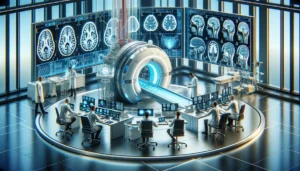Brain implants, also known as neural implants or brain-machine interfaces (BMIs), represent a remarkable intersection of neuroscience, engineering, and ethics. This article delves into the evolution of brain implants, examining their development, applications, and the ethical implications they carry.
Early Experiments with Brain Implants and Theoretical Foundations
The journey of brain implants began in the early 20th century with neuroscientists experimenting with electrical brain stimulation. However, the conceptual foundation dates back to the 18th and 19th centuries. During this period, scientists like Luigi Galvani and Alessandro Volta discovered bioelectricity, revealing that electrical currents could activate nerve cells.
In the 1920s and 1930s, Canadian neurosurgeon Wilder Penfield made significant contributions. His experiments involved stimulating the brains of epilepsy patients during surgery, providing deep insights into the brain’s functional organization.
Technological Breakthroughs and Modern BMIs
The latter half of the 20th century saw rapid technological advancements crucial for brain implant development. The 1947 invention of the transistor and the miniaturization of electronic components later enabled the creation of smaller, more efficient devices.
Experiments in the 1960s and 1970s included directly implanting devices into the brain. These early endeavors mainly aimed to restore lost functions like hearing and vision. For example, developers created the first cochlear implants during this era, granting hearing to individuals with profound deafness.
Neural Decoding and Motor Prosthetics
A significant leap in brain implant technology occurred with neural decoding and motor prosthetics. In the late 20th and early 21st centuries, scientists developed systems that could interpret brain signals and convert them into movements of external devices. This innovation offered new possibilities for individuals with paralysis or motor neuron diseases.
A pivotal moment came in the early 2000s with the development of the first brain-controlled prosthetic limbs. These devices, controlled by electrodes implanted in the motor cortex, allowed robotic arms or legs to be controlled, offering new independence levels to disabled individuals.
Contemporary Applications and Future Prospects for Brain Implants
Brain implants serve various medical purposes, from treating Parkinson’s disease with deep brain stimulation to aiding individuals with spinal cord injuries in regaining movement. The field is rapidly progressing, with ongoing research into more advanced BMIs capable of providing sensory feedback or enabling more complex control of external devices.
Ethical Considerations and Challenges
The advancement of brain implants also brings forth numerous ethical concerns. Issues like privacy, consent, and potential misuse require careful consideration. Additionally, the risk of deepening social inequalities looms if these technologies remain accessible only to a privileged few. As brain implants continue to advance, prioritizing ethical considerations in their research and development is essential.
Brain Implants for Traumatic Brain Injury (TBI) Treatment
In recent years, the application of brain implants in treating Traumatic Brain Injury (TBI) has marked a significant advancement in the field. TBI, caused by external impacts to the head, can result in chronic cognitive, emotional, and physical impairments. Researchers and clinicians have been exploring how these devices can aid in recovering and managing these conditions.
Innovations and Applications in TBI Treatment
Brain implants for TBI treatment primarily focus on restoring lost functions and mitigating damage. One approach involves using implants to monitor and regulate brain activity. These devices can detect abnormal neural patterns, such as those seen in seizures common in TBI patients, and deliver electrical stimulation to normalize brain activity.
Another promising area is using implants to enhance neuroplasticity, the brain’s ability to reorganize itself by forming new neural connections. This is particularly crucial in TBI treatment, as it can aid in recovering functions lost due to brain damage. Implants stimulating specific brain areas can promote neural growth and reconnection, potentially restoring cognitive and motor functions over time.
Clinical Trials and Emerging Research
Several clinical trials and research projects are underway to evaluate the efficacy of brain implants in TBI treatment. These studies explore various technologies, including deep brain stimulation (DBS) and responsive neurostimulation systems. Early results have shown the potential to improve cognitive function, reduce symptoms of depression, and enhance the quality of life for TBI patients.
Challenges and Future Directions
Despite promising developments, applying brain implants in TBI treatment presents unique challenges. The brain’s response to injury is complex, and the effects of TBI can vary widely among individuals. This variability necessitates personalized approaches to implant technology and treatment protocols. Additionally, there are challenges related to the surgical risks, the long-term viability of implants, and ethical considerations in treating cognitive and behavioral symptoms.
The future of brain implants in TBI treatment is closely tied to advancements in neuroscience and bioengineering. As understanding of brain injury and recovery deepens and implant technologies become more sophisticated and personalized, these devices’ potential to significantly improve TBI patients’ lives increases.
Conclusion
The history of brain implants showcases human creativity and the relentless pursuit of scientific understanding. From the initial steps in electrical brain stimulation to today’s sophisticated BMIs, this field has consistently challenged the limits of possibility. Looking ahead, this technology holds immense potential to transform lives, but it also carries the responsibility to ensure their development and usage are ethical and equitable.
Now extending into TBI treatment, it illustrates a relentless scientific exploration and innovation journey. From restoring basic sensory functions to potentially aiding in the complex recovery process of TBI, brain implants continue to push the boundaries of medical science. As this field advances, it promises restored function and improved quality of life for patients. It poses significant ethical and practical challenges that must be navigated with care and foresight.







Does anyone know if Elon Musk’s Neuralink can be used to help people with TBI?
That’s a great question. We will research and try to post something on that topic. Stay tuned.